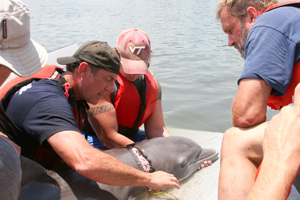Northern Wildfire Smoke May Cast Shadow on Arctic Warming - July 2, 2008

Members of the Southeast Regional Marine Mammal Stranding Network successfully removed a black rubber strap Tuesday that was wrapped around the head of a juvenile bottlenose dolphin, averting a life-threatening injury.
In a coordinated effort, NOAA and network members located the juvenile dolphin in the Wilmington River, part of the intracoastal waterway near Savannah, Ga., and removed the piece of rubber that had wrapped around the area between its flippers and blowhole.
The team of scientists from NOAA, the Georgia Department of Natural Resources, Savannah State University, University of North Carolina at Wilmington, University of Georgia Marine Extension, Harbor Branch Oceanographic Institute and others, began by carefully capturing the dolphin. An experienced marine mammal veterinarian gave the animal a complete physical exam and removed the rubber strap. The dolphin was then released into the river.
"We launched a rescue effort for this dolphin because the animal was entangled in marine debris and the entanglement was life-threatening," said Jenny Litz, a NOAA Fisheries biologist. "As the dolphin was growing, the piece of rubber was tightening around its body and could have lead to infection."
This injury is an example of the growing threat of marine debris to mammals and other animals in ocean waters. Rope, plastic materials and other debris discarded by humans can entangle, suffocate, starve and kill fish, turtles and marine mammals.
NOAA works to address the problem of marine debris through prevention and removal. NOAA-supported marine debris removal projects are underway in coastal communities around the nation.
The National Oceanic and Atmospheric Administration, an agency of the U.S. Commerce Department, is dedicated to enhancing economic security and national safety through the prediction and research of weather and climate-related events and information service delivery for transportation, and by providing environmental stewardship of our nation's coastal and marine resources. Through the emerging Global Earth Observation System of Systems (GEOSS), NOAA is working with its federal partners, more than 70 countries and the European Commission to develop a global monitoring network that is as integrated as the planet it observes, predicts and protects.
 Deep Sea Crabs
Deep Sea Crabs